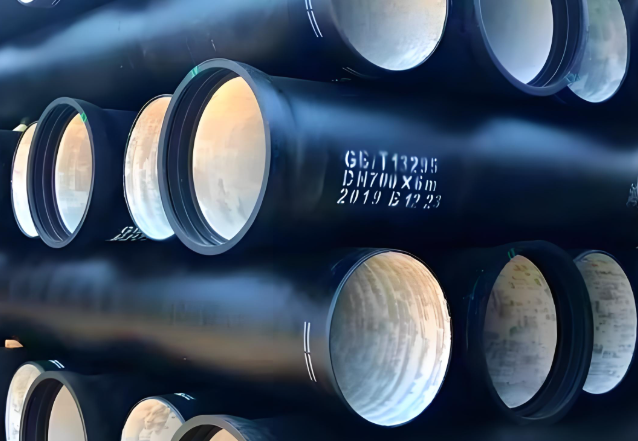Ductile iron, also known as spheroidal graphite iron (SG iron), is a type of cast iron distinguished by its unique microstructure. Unlike traditional gray cast iron, which contains graphite flakes, ductile iron features graphite in the form of spherical nodules. This structure significantly enhances its strength, ductility, and impact resistance, making it suitable for demanding applications.

🔬 Composition of Ductile Iron
The primary components of ductile iron include:
-
Iron (Fe): Forms the base of the alloy.
-
Carbon (C): Typically ranges from 3.0% to 3.7%, contributing to the formation of graphite.
-
Silicon (Si): Aids in graphite formation and improves fluidity; usually between 1.8% and 2.8%.
-
Manganese (Mn): Acts as a deoxidizer and helps in controlling sulfur and oxygen levels; generally less than 0.8%.
-
Magnesium (Mg): Introduced during production to promote the formation of spherical graphite nodules.
-
Phosphorus (P): Limited to less than 0.1% to prevent brittleness.
-
Sulfur (S): Kept below 0.03% to avoid the formation of iron sulfides, which can weaken the material.
Additional elements like nickel, copper, chromium, and tin may be added to enhance specific properties such as strength, corrosion resistance, or wear resistance.
🧬 Microstructure of Ductile Iron
The unique mechanical properties of ductile iron arise from its microstructure, where graphite is present in the form of spherical nodules. This structure is achieved by adding magnesium during the production process, which alters the solidification pattern of the iron. The nodular graphite inclusions prevent crack propagation, thereby improving the material’s ductility and toughness.
⚙️ Mechanical Properties
| Property | Description |
|---|---|
| Tensile Strength | Ranges from 350 to 700 MPa, depending on the grade. |
| Yield Strength | Typically between 250 and 500 MPa. |
| Elongation | Generally between 5% and 15%, indicating good ductility. |
| Hardness | Varies from 170 to 300 HB, depending on the alloy and heat treatment. |
| Impact Toughness | High, making it suitable for applications subject to dynamic loads. |
| Fatigue Strength | Superior to gray cast iron, enhancing durability under cyclic loading. |
🏭 Applications of Ductile Iron
Ductile iron’s enhanced properties make it ideal for various applications:
-
Pipes and Fittings: Used in water and wastewater systems due to its strength and corrosion resistance.
-
Automotive Components: Crankshafts, gears, and suspension parts benefit from its high strength-to-weight ratio.
-
Agricultural Machinery: Components like plowshares and tractor parts require the durability of ductile iron.
-
Construction Equipment: Parts subjected to heavy loads, such as excavator components, utilize ductile iron for its toughness.
❓ Frequently Asked Questions (FAQs)
Q1: How is magnesium added to iron to produce ductile iron?
Magnesium is introduced into molten iron through a process known as “nodulizing,” where magnesium alloys are added to the melt, promoting the formation of spherical graphite nodules during solidification.
Q2: Can ductile iron be welded?
Yes, ductile iron can be welded, but it requires preheating and post-weld heat treatment to prevent cracking due to its carbon content and microstructure.
Q3: What are the advantages of ductile iron over gray cast iron?
Ductile iron offers higher tensile strength, improved ductility, better impact resistance, and enhanced fatigue strength compared to gray cast iron, making it suitable for more demanding applications.
Q4: Is ductile iron corrosion-resistant?
Ductile iron has good corrosion resistance, especially when alloyed with elements like nickel or chromium. However, for highly corrosive environments, additional protective coatings may be necessary.
📚 Conclusion
Ductile iron is a versatile material known for its combination of strength, ductility, and toughness. Its unique composition and microstructure make it suitable for a wide range of applications across various industries. Understanding its composition and properties can assist engineers and manufacturers in selecting the appropriate material for their specific needs.

